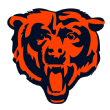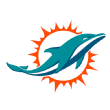It has been a very, very bad start for the Miami Dolphins, who have been outscored 102-10 in their first two losses to Baltimore and New England. To add insult to insult, both games were at home.
Is this the worst start in the history of the NFL? Football Outsiders' DVOA rating suggests that this is at least the worst start in the modern history of the NFL. DVOA breaks down play-by-play to look at how well teams play adjusted for situation and opponent (explained more here). We have that play-by-play data back to 1986, and sure enough, the 2019 Dolphins find themselves among the 10 worst teams of the past 34 seasons through two games.
We went back and looked at the 10 worst teams ever measured by DVOA through Week 2 and then looked at what those teams did the rest of the season. What we found was that a dismal start does not necessarily doom a team to a dismal season. Most of these teams ended up playing close to preseason expectations. One even outperformed expectations and went to the playoffs, despite a two-game start in the same range as Miami's. But none of these teams had preseason expectations as low as those for the 2019 Dolphins.
A couple of caveats before we count down the 10 worst starts: Although DVOA normally includes adjustments for opponent strength, those adjustments are not included in the first three weeks of the season, so they aren't accounted for in these ratings. We aren't including teams before DVOA exists, so you won't find the 1961 Raiders, who lost their first two games by a combined score of 99-0. Also, the worst Week 1-2 results by DVOA will not quite be the same as the worst Week 1-2 results by other measurements. For example, the 2011 Kansas City Chiefs lost their first two games by a combined score of 89-10 but they were only 12th on our DVOA list.

10. 2003 Chicago Bears: -88.3% DVOA
49-7 loss at 49ers; 24-13 loss at Vikings
Expectations: The 2002 Bears collapsed from 13-3 to 4-12, so there was some expectation of a rebound in 2003. The preseason over/under was 7.5.
Weeks 1-2: Most of the negative DVOA value for the Bears came in a Week 1 annihilation at the hands of the San Francisco 49ers. The 49ers outgained the Bears 391-127 and had a plus-three turnover margin. Dick Jauron decided to start offseason pickup Kordell Stewart -- did you even remember his year in Chicago? -- over veteran Chris Chandler and first-round rookie Rex Grossman. Stewart was a miserable 14-for-34 in the first game, with 95 yards plus three picks (one was a pick-six) and five sacks. Halfbacks Anthony Thomas and "the other" Adrian Peterson combined for 27 yards on 11 carries. Things would have been even worse except the San Francisco offense bogged down in the red zone, and Jeff Chandler kicked five field goals of fewer than 30 yards.
Stewart started again in Week 2 and was barely any better: 13-for-21 and 137 yards with three sacks. At least he had no interceptions in Week 2. The Bears did a good job of covering Randy Moss, limiting him to 27 receiving yards, but Daunte Culpepper competed 20 of 26 mostly short passes, and the Bears' run defense gave way, allowing the Vikings 39 carries for 202 yards.
What happened next: The Bears started 1-5, with their only win coming by three points at home against the collapsing post-Jon Gruden Oakland Raiders. Then the Bears turned things around and started winning, and they finished the season 7-9. The 2003 Bears' passing game was dismal all season, with a rotating quarterback carousel, and finished dead last in passing DVOA. But the running game and the defense rebounded to be league average. With rookies Lance Briggs and Charles Tillman joining third-year starter Brian Urlacher, the Bears were starting to build a defense that would eventually get to the Super Bowl.

9. 2005 Minnesota Vikings: -89.3% DVOA
24-13 loss to Buccaneers, 37-8 loss at Bengals
Expectations: Coming off an 8-8 season with the defense adding veterans such as Pat Williams, Sam Cowart and Darren Sharper, the 2005 Vikings were expected to be playoff contenders, with an over/under of 9.0, despite having dealt Randy Moss to Oakland in the offseason.
Weeks 1-2: Culpepper was awful in Week 1, with no touchdowns, three interceptions and three sacks against a still well-regarded Tampa Bay pass defense. Running backs Moe Williams and Michael Bennett were limited to 12 carries for 14 yards. The Vikings fumbled four times, with each team recovering two. But the new-look defense played reasonably well.
In Week 2, the new-look defense did not play reasonably well. In Carson Palmer's second NFL start, the Bengals outgained the Vikings 504 yards to 304. Meanwhile, Culpepper threw five interceptions, three of them to cornerback Deltha O'Neal. The game would have been an even bigger blowout if not for 17 penalties committed by Cincinnati for 115 yards.
What happened next: By our DVOA ratings, the Vikings were a terrible team for the rest of 2005. They finished just 25th in DVOA for the season: 26th on offense and 23rd on defense. However, the Vikings turned things around after a 2-5 start, when an injured Culpepper was replaced by Brad Johnson. Despite their poor DVOA performance, they won six straight games at midseason. Thanks in part to a 4-1 record in one-score games, the Vikings finished the season 9-7, matching preseason over/under expectations, but they did not make the playoffs.

8. 1996 Tampa Bay Buccaneers: -91.7% DVOA
34-3 loss to Packers, 21-6 loss at Lions
Expectations: The Bucs had an over/under of 6.5 in Tony Dungy's first season as head coach.
Weeks 1-2: Brett Favre and the Packers were on the way to one of the five best seasons in DVOA history, and they started by crushing the Bucs in Week 1. The Bucs were outgained 406-176 with a minus-four turnover margin. It's a game that doesn't look quite so bad once opponent adjustments are applied.
The same can't be said for the Week 2 loss to the Lions, who finished the season 5-11. The Bucs actually outgained the Lions in this game but had a minus-three turnover margin, including a pick-six by Courtney Raymond.
What happened next: The Bucs ended up with a 1-8 start, though many of those losses were close. After a Week 6 bye, the defense started to come together, limiting opponents to fewer than 20 points in seven straight games (three of which the Bucs lost anyway). The offense perked up a bit in November, and eventually the Bucs finished 20th in overall DVOA. They won five of their last seven games to finish 6-10, building toward the team that made the playoffs in 1997.

7. 2018 Buffalo Bills: -94.0% DVOA
47-3 loss at Ravens, 31-20 loss to Chargers
Expectations: Despite coming off a playoff year, the Bills were clearly rebuilding, with an over/under of just 5.5.
Weeks 1-2: That's right, this year's Week 1 blowout of the Dolphins was not a new phenomenon for the Baltimore Ravens. They've blown out their Week 1 opponents in three straight years, including this destruction of the 2018 Bills plus a 20-0 win over the Bengals in 2017. Somehow, Nathan Peterman threw "only" two picks, but he went 5-for-18 for just 24 yards. Then Josh Allen came in and went 6-for-15 for another 74 yards. Each quarterback took three sacks. On the other side, Joe Flacco was completing 25 of 34 passes for 236 yards, three touchdowns and no picks.
In Week 2, the Chargers took a 28-3 lead over the Bills near halftime, but the Bills got some offense going in the second half and made the final margin a lot closer. By the end, the Chargers had outgained the Bills by only 56 yards, though they had a plus-two turnover margin.
What happened next: Buffalo used four starting quarterbacks during the season, but it looked a lot better when Allen came back healthy to start the final six games. Despite the horrendous start, the Bills went over their preseason number by finishing 6-10.

6. 1997 Seattle Seahawks: -95.5% DVOA
41-3 loss to Jets, 35-14 loss to Broncos
Expectations: Coming off a 7-9 year, the Seahawks gave up on quarterback Rick Mirer and brought in 41-year-old Warren Moon. Add him to defensive additions including veterans Sam Adams and Chad Brown and rookie third overall pick Shawn Springs, and the Seahawks had a preseason over/under of 8.5.
Weeks 1-2: So much for that new-look defense. The Seahawks' defensive DVOA was 59.4% after Week 2, the worst for any defense since 1986. In Week 1, they were outgained 6.6 yards per play to 4.0. Neil O'Donnell threw five touchdowns for the Jets with no sacks or interceptions.
Week 2 was a little closer, as the Seahawks were outgained only 5.7 yards per play to 5.0. Seattle is the only team on this list other than Miami to have its two huge early losses both come at home.
What happened next: Things turned around for the Seahawks immediately, as they won five of their next six games, with the only loss coming in overtime. Later they lost four straight, all by one score or less, and then won their final two games to finish 8-8. After the worst defensive start in DVOA history, the Seahawks finished 19th in defensive DVOA.

5. 1989 Pittsburgh Steelers: -100.5% DVOA
51-0 loss to Browns, 41-10 loss at Bengals
Expectations: Low. The Steelers were a rebuilding team coming off a 5-11 season and had an over/under of 6.0.
Weeks 1-2: Pittsburgh's minus-82 point differential in Weeks 1-2 is the fourth-worst since 1960, trailing only that of the 1961 Raiders (99), the 2019 Dolphins (92) and the 1973 Saints (also 92). The 51-0 loss is the worst Week 1 performance in DVOA history. Pittsburgh was outgained 357 yards to 53. They had five first downs. Five! They had eight turnovers, three of which were returned for scores.
In Week 2, the offense was better, but the defense was worse. The offense gained 274 total yards and didn't turn the ball over. But the defense allowed Cincinnati to gain 520 yards. Boomer Esiason had 328 yards on just 27 pass attempts with no picks or sacks; the Bengals also had 37 carries for 192 yards and three touchdowns on the ground.
What happened next: Perhaps the craziest result of any of the teams listed here. The Steelers, coming off a bad 1988 season and the horrific performance of their first two games and despite being shut out three times over the course of the season, made the playoffs. Pittsburgh won five of its last six games, finishing 19th in total DVOA. The Steelers pulled off a 9-7 record and sneaked into the playoffs in an extremely unbalanced year in which only one AFC team had more than nine wins, and two teams in the NFC stayed home at 10-6. The Steelers even won a playoff game, 26-23 over Houston, before falling to Denver in the divisional round. Chuck Noll won Coach of the Year for the only time in his career.
This is the -- very, very unlikely -- best-case scenario for the 2019 Miami Dolphins.

4. 2008 St. Louis Rams: -103.3% DVOA
38-3 loss at Eagles, 41-13 loss to Giants
Expectations: The Rams were 3-13 the season before, but with some talent on offense (Marc Bulger, Torry Holt, Steven Jackson, plus Orlando Pace returning from a year lost to injury), they were expected to rebound a little bit. They had an over/under of 6.5.
Weeks 1-2: What's remarkable is how low the Rams' DVOA was in the first two weeks of the season, despite their not having many turnovers. In the Week 1 loss to the Eagles, they had a fumble but recovered it. In Week 2's loss to the Giants, they had just one interception, returned for a pick-six by Justin Tuck. But they were outgained on a per-play basis by a ridiculous amount. In Week 1, they were outgained 7.4 yards per play to 3.7 and went 0-for-11 converting third downs. In Week 2, they were outgained 7.1 yards per play to 3.7, though they at least converted a couple of third downs (3-for-13).
What happened next: For the most part, the story of this list has been the ability of NFL teams to come back from horrific starts. This is the first team for which the first two losses were emblematic of the dismal season to come. The Rams finished 2-14 with one of the five worst DVOA ratings in history. Only the 0-16 Lions kept them from being the worst team in the league. (The winless Lions, by the way, were 29th all time among 0-2 teams, with minus-59.6% DVOA after Week 2, losing their first two games by a more respectable combined score of 82-46.)
A season like the Rams' in 2008 is the most likely scenario for the Miami Dolphins.

3. 1999 Cleveland Browns: -103.5% DVOA
43-0 loss to Steelers, 26-9 loss at Titans
Expectations: Over/under of 5.0, which is surprisingly high for an expansion team.
Weeks 1-2: The question is why more expansion teams don't lose their first game by scores like 43-0. This was the second-worst Week 1 loss in DVOA history, narrowly ahead of that 1989 Steelers-Browns game that went the other way. Pittsburgh outgained Cleveland 464 yards to 40, and the Browns had a minus-six turnover margin. They ran the ball nine times for nine yards and were 0-for-7 on third downs. They lost the time of possession battle 47:49 to 12:11.
Week 2 was much closer. The Browns benched Ty Detmer for rookie -- and No. 1 overall pick -- Tim Couch, who went 12-of-24 for 134 yards and a touchdown, though he was sacked seven times. The Browns managed 173 total yards (to 412 for Tennessee) and turned the ball over only once. They even converted four of 11 third downs.
What happened next: Like the 2008 Rams, the 1999 Browns were lousy all season. What do you want? They were an expansion team! Surprisingly, the 2-14 Browns did not finish the season in last place in DVOA, narrowly being out-terribled by the 3-13 New Orleans Saints.

2. 2001 Washington Redskins: -107.8% DVOA
30-3 loss at Chargers, 37-0 loss at Packers
Expectations: Washington was coming off a disappointing 8-8 record in 2000, but expectations were high with new head coach Marty Schottenheimer. The over/under was 9.5 wins, and only six teams had higher Super Bowl odds before the season began.
Weeks 1-2: The Washington defense was pretty good in Week 1, limiting San Diego quarterback Doug Flutie to 10-for-18, just 129 passing yards, no passing touchdowns and two interceptions. But the Washington offense was horrendous, with just 3.1 yards per play and two Jeff George interceptions. Washington also fumbled seven times: three by Stephen Davis, two by George, one by Tony Banks replacing George and one by Michael Bates on a kickoff return. All of these are penalized in the DVOA formula, even if Washington did manage to recover five of them.
Week 2 was worse, as the Redskins got shut out on Monday Night Football. Once again, the defense wasn't really the problem. Green Bay had a slightly above average 5.4 yards per play, and Brett Favre had three touchdown passes but also a pick. On the other hand, Washington had just 3.1 yards per play. George had a mere 102 yards passing and took five sacks.
Special teams were also a problem in both games. In Week 1, Washington allowed Tim Dwight an 84-yard punt return touchdown. In Week 2, punter Bryan Barker shanked a punt for just 12 yards and put only one of his eight punts inside the 20, while Bates fumbled another two times on returns, one of which the Packers returned for a touchdown.
What happened next: Washington benched George after Week 2 and turned to Banks as the starting quarterback but kept losing. They got destroyed again in Week 3 45-13. They lost in Weeks 4 and 5 and ended up averaging 6.4 points in their first five games. Then things turned around, and they won five straight games. Eventually, Washington finished the season 8-8: below expectations but far better than anyone could have expected after the atrocious first two losses. The Redskins ranked 17th in the final DVOA ratings, the highest of any of the teams in this article.

1. 2019 Miami Dolphins: -114.7% DVOA
59-10 loss to Ravens, 43-0 loss to Patriots
Expectations: Very low, as the team was rebuilding to the point of outright tanking. The preseason over/under was just 4.5. Miami was the first team since the 2010 St. Louis Rams to average fewer than 5.0 wins in Football Outsiders' final preseason simulation.
Weeks 1-2: You know. No team in NFL history had been outscored by more than 60 points in Weeks 1-2 at home. The Dolphins were outscored by 92 points and would have been outscored by more if Stephen Gostkowski had not missed a field goal and an extra point in Week 2. Miami was outgained 8.8 yards per play to 4.3 in Week 1, then 5.8 yards per play to 3.0 in Week 2. Quarterbacks Ryan Fitzpatrick and Josh Rosen have combined for six interceptions, though Rosen's interception on the final play against New England was meaningless.
Miami has the worst DVOA rating ever through Week 2. The Dolphins have the fifth-lowest offensive rating and the 12th-lowest defensive rating. No other team since 1986 is in the bottom 20 for both offense and defense.
What happens next: The good news for Miami -- or bad news, depending on how you want to look at the Fish Tank -- is that a lot of the teams on Miami's schedule are having their own problems. Based on Football Outsiders' DAVE ratings -- which combine early performance with preseason forecasts -- Miami's remaining average opponent ranks 27th in the NFL. Whether it's the Giants, the Jets or the Bengals, there will be games in which Miami can be competitive.
Nevertheless, as of right now, Football Outsiders simulations give Miami a 3.8% chance of going 0-16 and a 43.9% chance of earning the No. 1 pick in the 2020 draft.
